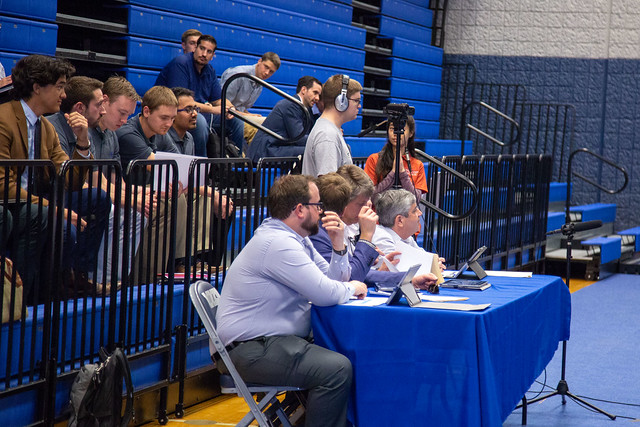An integrated sensor network designed for active real-time monitoring of mine structures and accurate location of personnel and equipment won the top prize at the 2018 HackMines Newmont Innovation Challenge.
Point Mine Innovations won a $2,500 cash prize and up to $7,500 in grants from the Newmont Innovation Fund to further develop their proposal. A panel of Newmont mining experts judged the final pitch competition April 26.
"This experience has been extremely valuable for our team and also lots of fun," said team member Zach Nahman, a computer science master's student. "We're currently deciding what our next steps are as a team. However, clearly there is industry interest in the technology that we are working on developing. This is very encouraging toward maintaining our work on the solution."
The team's initial idea was to analyze the drone flyability of an underground mine, inspired by Computer Science Assistant Professor Hao Zhang's Human-Centered Robotics Lab, Nahman said. But they decided to pivot toward a problem that felt more compelling: real-time data analysis that could warn of mine cave-ins and provide centimeter-accuracy localization of all personnel and equipment underground.
The sensors they proposed would be able to detect millimeter changes in the mine's structure and warn workers of any potential danger. Workers would also be issued beacons that feed into the network, providing much more accurate locations in the event of a mine collapse or other emergency.
All in all, the experience taught them a lot about getting multiple perspectives on a project and not giving up on their goals, said team member Joshua Graber, a mechanical engineering master's student. Rounding out the team were engineering physics major Jacob Aas and computer science master's student Saichand Bandarupalli.
"Getting many perspectives about projects is one of the most valuable things that you can do – provided you think critically for yourself about what everybody says and decide based on a lot of, not just several, perspectives. On that same note, I learned not to be discouraged by a couple of bad reviews, because when we got the most negative impression of our idea we had actually already discovered our final and best possible idea," Graber said. "There are many technologies out there that are just waiting to be harnessed in new ways for very useful applications."
Especially helpful were the Lean Canvas exercises and six-week entrepreneurship course with Bud Rockhill at Traxion, a Golden-based business accelerator, and Werner Kuhr, director of the Center for Entrepreneurship & Innovation at Mines, which was offered to all of the finalist teams, Nahman said.
"The six-week course on developing the business proposal and presentation provided skills that are applicable in school, life and work. In industry, it's critical to be able to clearly communicate compelling ideas, especially when the ideas have the potential to save lives," Nahman said. "This experience helped us learn how to communicate complicated ideas very smoothly and effectively."
Coming in second place was JCG Mining Data Decentralization, for their blockchain data storage solution for the mining industry. They won $1,500 in cash and up to $3,500 in grants to further develop their idea.
Team member Gage Coprivnicar said the innovation challenge did an excellent job, in just one semester, of introducing, developing and applying business fundamentals. His teammates were
chemical and biochemical engineering major Julian Paik and computer science major Connor Koch.
"With our final pitch, winning second place, we decided we are going to further develop this technology and the company," said Coprivnicar, an electrical engineering major. "As a team we collectively learned how to put together an effective business proposal and how to sell to a specific consumer. These skills are incredibly useful."
Third place went to Cryogenically Cooler than You, for their noninvasive rapid ore detection system using superconducting quantum interference device magnetometers and cryocoolers. Their prize was $1,000 in cash and up to $2,500 in product development grants. Forming the team were chemical and biochemical engineering major Logan Sewall, metallurgical and materials engineering major Andrew Pera and engineering physics major Chantal Wang.
"It was great to see such a diverse set of students competing in this Innovation Challenge – we had such a diverse set of skills represented, ranging from computer science to mining engineering, as well as a breadth of experience, from freshmen to graduate students," Kuhr said. "That truly represents the needs of the modern mining industry and helps to bring that intersection of talents together – this is necessary to create the kind of innovation and value required to respond to high-stakes challenges."
CONTACT
Emilie Rusch, Public Information Specialist, Communications and Marketing | 303-273-3361 | erusch@mines.edu
Mark Ramirez, Managing Editor, Communications and Marketing | 303-273-3088 | ramirez@mines.edu
Emilie Rusch, Public Information Specialist, Communications and Marketing | 303-273-3361 | erusch@mines.edu
Mark Ramirez, Managing Editor, Communications and Marketing | 303-273-3088 | ramirez@mines.edu




